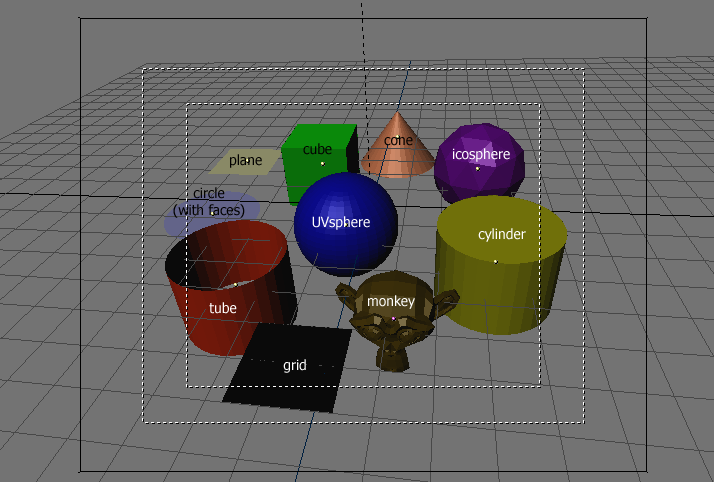Mesh Modelling
The principal Object of a 3D scene is usually a Mesh. In this chapter we will first enumerate the basic mesh objects, or primitives, then a long series of sections describing in detail the actions which can be taken on Mesh Objects.
Basic objects
To create a basic object press SPACE and select "ADD>>Mesh". You can also access the 'add'-menu by pressing SHIFT-A. Then you can select the basic object you'd like to create. Every basic object or primitive you can create within Blender is described below. Figure 1 also shows the different basic objects that can be created.
Plane
A standard plane is made out of 4 vertices, 4 edges and one face. It is like a piece of paper lying on a table. A plane is not a real 3-dimensional object, because it is flat and has no 'thickness'. Example objects that can be created out planes are ground surfaces or flat objects like tabletops or mirrors.
Cube
A standard cube is made out of 8 vertices, 12 edges and 6 faces and is a real 3-dimensional object. Example objects that can be created out of cubes are dice, boxes or crates.
Circle
A standard circle is made out of n vertices. The number of vertices can be specified in the popup window which appears when the circle is created. The more vertices it consists of, the smoother the circle's contour becomes. Example objects that can be created out of circles are discs, plates or any kind of flat round object.
UVSphere
A standard UVsphere is made out of n segments and m rings. The level of detail can be specified in the popup window which appears when the UVsphere is created. Increasing the number of segments and rings makes the surface of the UVsphere smoother. Segments are akin to Earth meridians, rings to earth parallels. Just for your information, if you ask for a 6 segment 6 ring UVsphere you'll get something which, in top view, is a hexagon (6 segments) and has 5 rings plus two points at the poles, hence one ring less than expected, or two more, depending if you count the poles as rings of radius 0. Example objects that can be created out of UVspheres are balls, heads or pearls for a necklace.
Icosphere
An Icosphere is made up of triangles. The number of subdivisions can be specified in the window that pops up when the Icosphere is created. Increasing the number of subdivisions makes the surface of the Icosphere smoother. At level 1 the Icosphere is an icosahedron, a solid with 20 equilateral triangular faces. Any increasing level of subdivision splits each triangular face into four triangles, resulting in a more 'spherical' appearance. This object is normally used to achieve a more isotropical and economical layout of vertices, in comparison to a UVsphere.
Cylinder
A standard cylinder is made out of n vertices. The number of vertices in the circular cross-section can be specified in the popup window that appears when the object is created. The higher the number of vertices, the smoother the circular cross-section becomes. Example objects that can be created out of cylinders are handles or rods.
Tube
A standard tube is made out of n vertices. The number of vertices in the hollow circular cross-section can be specified in the popup window that appears when the object is created. The higher the number of vertices, the smoother the hollow circular cross-section becomes. Example objects that can be created out of tubes are pipes or drinking glasses. The basic difference between a cylinder and a tube is that the former has closed ends.
Cone
A standard cone is made out of n vertices. The number of vertices in the circular base can be specified in the popup window that appears when the object is created. The higher the number of vertices, the smoother the circular base becomes. Example objects that can be created out of cones are spikes or pointed hats.
Grid
A standard grid is made out of n by m vertices. The resolution of the x-axis and y-axis can be specified in the popup window which appears when the object is created. The higher the resolution, the more vertices are created. Example objects that can be created out of grids are landscapes (with the proportional editing tool) or other organic surfaces.
Monkey
This is a gift from NaN to the community and is seen as a programmer's joke or 'Easter Egg'. It creates a monkey's head after you have pressed the 'Oooh Oooh Oooh' button.
